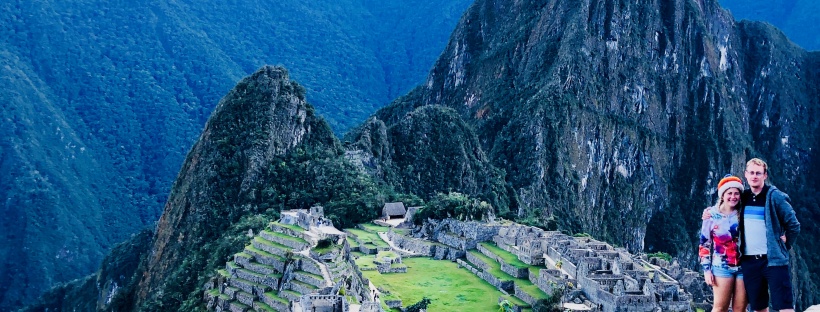The Inca Trail is probably the most famous trek in South America, winding up and down the Andes mountains, through coud forests and Inca ruins, and ending at the spectacular once-forgotten city of Machu Picchu.
The Inca Trail is also carefully controlled by the Peruvian government. Only 500 people each day (including guides and porters) are allowed to start the trail, and permits are issued to tour operators on a first-come, first-served basis. The most popular time to hike the trail is between June and August, and while Oasis trips from Quito to Rio usually include the Inca Trail to Machu Picchu, by the time we booked our trip in February, the permits for the Inca Trail were long gone.
We weren’t the only ones out of luck. From our group only Holly and Hattie booked far enough in advance to secure a permit. For Andrea, James, Jess, Marisa, Ryan, Will, Shane and I, an alternative trail was offered: the Salkantay Trek. While this isn’t as iconic as the famous Inca Trail, the premise is similar (a difficult, mountain-based walk to Machu Picchu), and what it lacks in Inca ruins along the way it makes up for with spectacular views, variety and tranquility.
With the Lonely PLanet describing the Salkantay Trek as “incredibly demanding”, featuring several days of solid walking and reaching heights of 4,600 metres above sea level, it’s fair to say I was a little worried. Trekking to Machu Picchu isn’t compulsory – it is possible to get the train straight there from Cuzco – but I couldn’t help feeling that I should participate in the trek. Partly because it was included in our Oasis trip, partly because I couldn’t escape the nagging feeling that taking the train was somehow cheating, and partly because I knew that even my Dad had managed to complete the Inca Trail a few years ago. I mean, if my Dad could do it, how hard could it be?
DAY ZERO
We arrived in Cuzco with a day to spare before we started our trek. It also happened to be Shane’s birthday.
In the morning we met our guide, Christian, who would be with us all the way from Cuzco to Machu Picchu. He gave us an outline of the trek, told us what to bring, gave us a special duffel bag (which we could fill with seven kilograms of our belongings, and which would be carried by horses), and answered our many questions.
We then started to pack our bags, venturing to the local market in Cuzco to repair and replace Shane’s only pair of walking trousers. In the afternoon Shane led Andrea, James and I on a walking tour of Cuzco. We visited various churches and cathedrals, the trendy San Blas area, an old Inca temple (knocked down by the Spanish and now also a church), and watched a parade marching through the square. In the evening we went out for a group dinner to celebrate Shane’s birthday, but headed to bed early in preparation for an early start to our trek the next day.
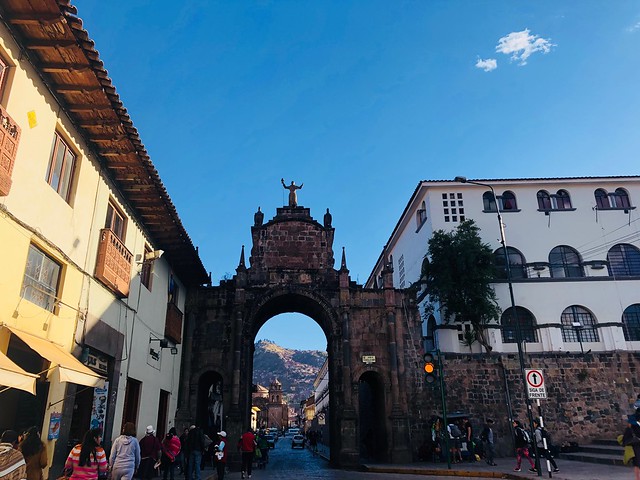
Historic Cuzco
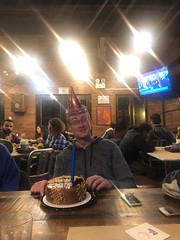
Celebrating Shane’s birthday
DAY ONE
Christian came to pick us up at 4.30am. We drove for two hours to the town of Mollepata, where we were dropped off at a restaurant for breakfast and it quickly became apparent that Jess was quite unwell. Christian told us we had 20 minutes for breakfast, but the service was so slow (even by South American standards) that after 20 minutes no one had even managed to place an order. Eventually we had to give up, and after some bread, some coffee and some trips to the toilet (mainly for Jess), we bundled back into the minibus and drove for another hour to Saraypampa to start our trek.
It wasn’t a great start for me. As soon as we started walking I realised (not that it came as a surprise) that (apart from Jess who was suffering), I was the slowest person in our group by quite a large margin. I knew that Andrea was super fit from her intense army training, and that Will had recently run the San Francisco marathon in a speedy time, and that everyone apart from Shane was significantly younger than me, but their pace still came as a bit of a shock.
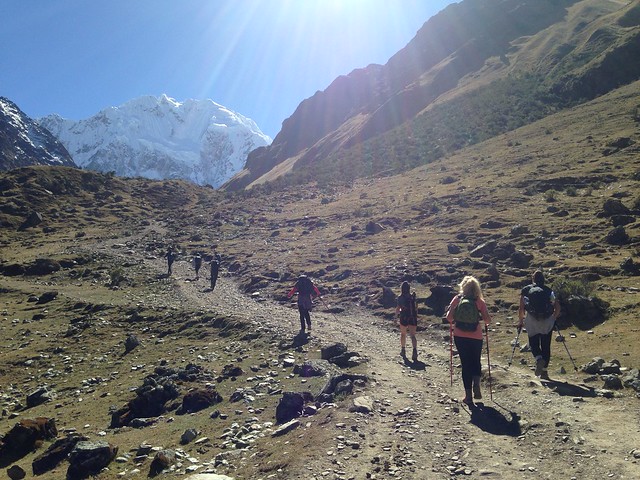
Climbing up (slowly)
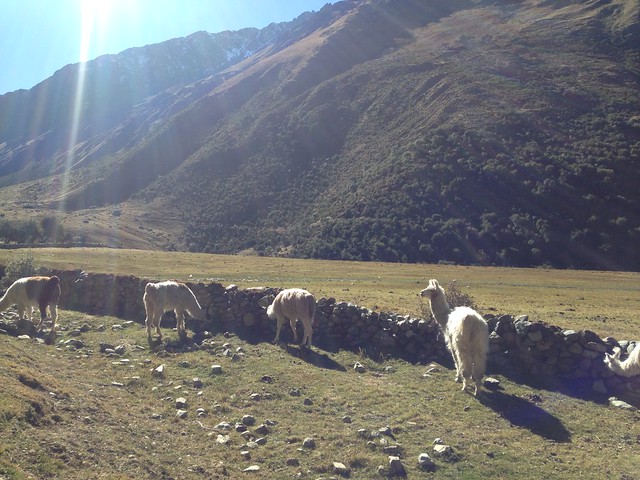
Alpacas at the bottom
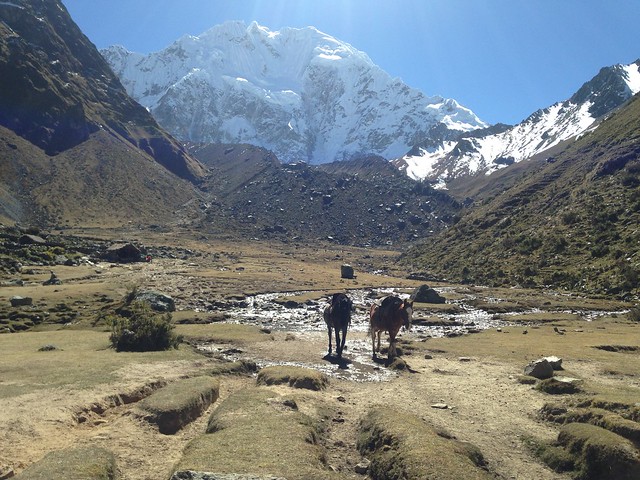
Views on the way up
The first part of the trek involved a 900 metre climb up to the Salkantay pass at 4,650 metres. As the others bounded up the mountain I tried to run in order to keep up. Obviously that didn’t work, and I quickly found myself worn out and frustrated.
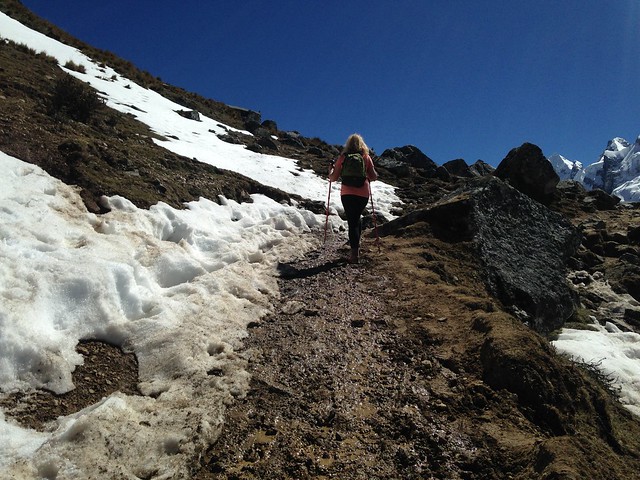
Climbing through snow and ice
Shane stayed at the back with me and murmured encouraging words, as I slowly plodded up the mountain. While the air became thinner with every step we climbed, the views also became more beautiful and dramatic. Rivers turned to ice around us as we climbed higher and higher, and after about three hours of climbing we reached the Salkantay pass at 4,650 metres. The sun was bright, the views of Mount Salkantay were spectacular, and even though I was the slowest to reach the top (apart from Jess who had ended up riding a horse called Fecundo), I still felt a great sense of achievement. I also felt a huge sense of relief; it was all downhill from here.
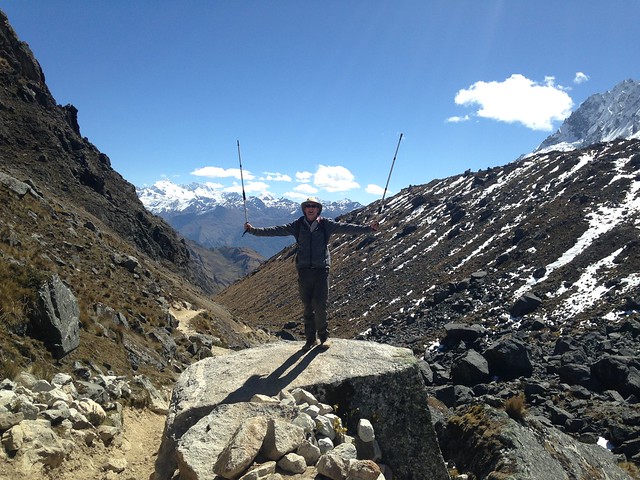
At the top
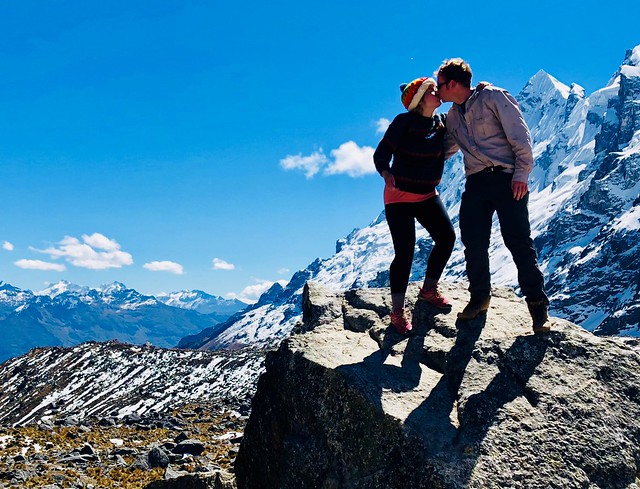
Love at 4,650 metres
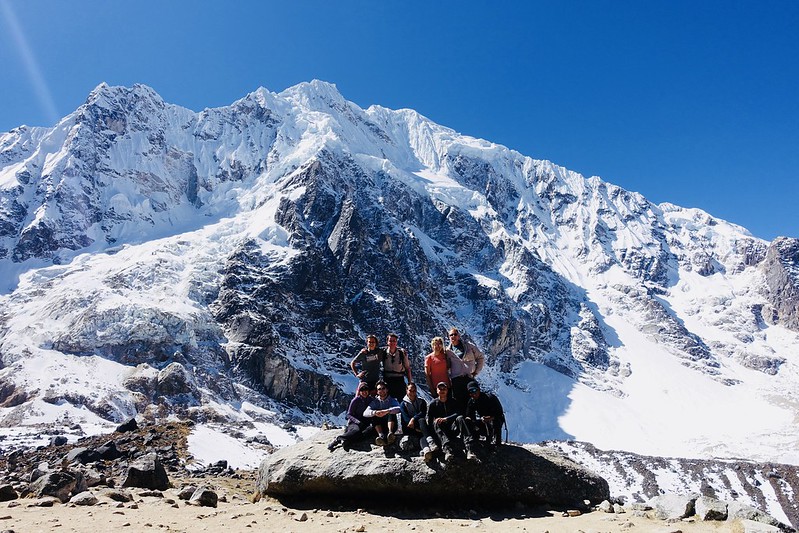
Our group
—
Downhill didn’t mean a slower pace though. As the group rushed down the mountain, I slipped on the rocks and gravel trying to keep up. At one point I ended up at the back of the group, flat on my back and unable to get up. I felt like a tortoise, with my head dangling over the edge of the path. I had to wait for Shane to realise I was gone and to come back and help me in order to continue.
By this time it was about 1.30pm, and after a very early start , no real breakfast to speak of and a lot of walking, the whole group was starving. Christian reassured as that lunch was a mere half an hour away, and we continued to walk and slide down the hill.
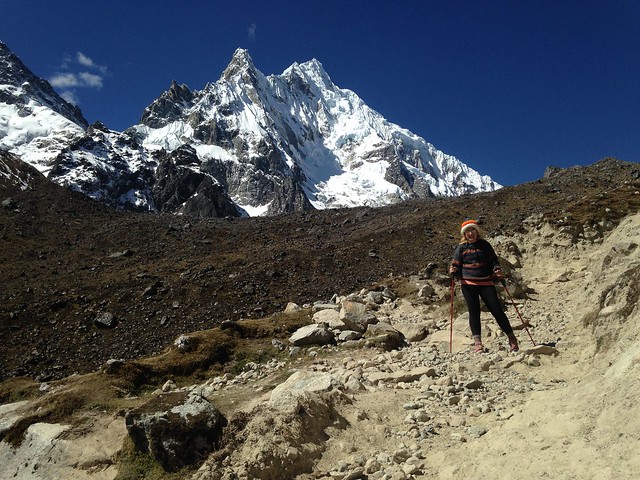
What goes up…
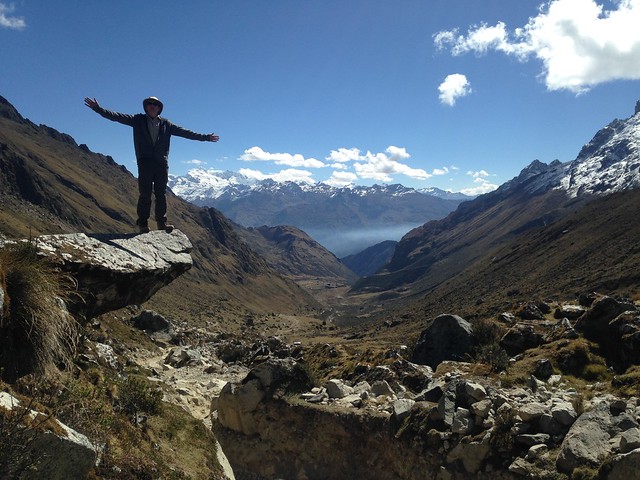
On the way down
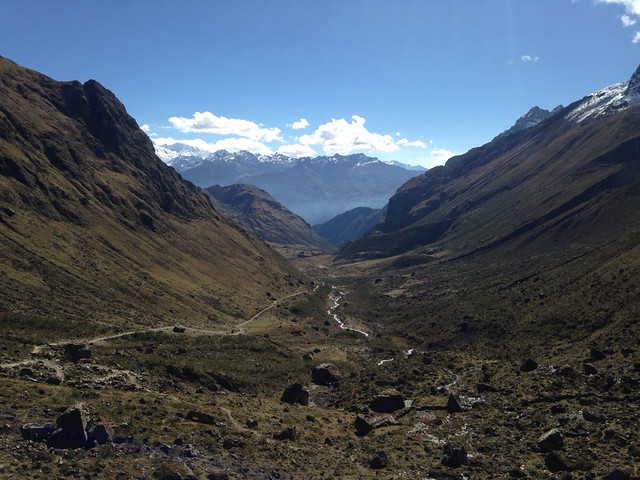
Valley views
Of course, “half an hour” never actually means half an hour in South America. What it actually means is “at some point in the future, probably at least an hour or two from now, you may get lunch”. In our hunger and tiredness, we had forgotten this crucial fact, and so were quite disappointed when half an hour came and went, and there was no sign of lunch on the horizon. We had no choice but to continue climbing down into the valley, and eventually, maybe an hour and a half later, met Christian. He pointed at a small building a long way off in the distance: “Lunch!”
Once we arrived at the lunch stop, the food was quick and delicious. We had a vegetable soup followed by lomo saltado, a traditional Peruvian stir fry with marinated strips of beef with onions, tomatoes and rice. It was delicious, and gave us a renewed sense of energy, ready for the next stage of the journey.
The only problem was, we had a lot further to go than we thought. Christian had told us it would take three hours to get to the top of the mountain pass, and then three or four hours to get from the top down to our campsite in Chaullay. It had indeed taken us three hours to get to the top, but we had been walking downhill for nearly two hours, and yet still had another three or four hours of walking to go. “We’d better get going”, Christian nudged. “If we leave now we can get there by 6.30.” Great.
I was already exhausted, but with no option but to continue, I found my headphones, grabbed my walking poles, put on Beyonce and marched as quickly as I could towards the campsite. At this point I think it’s fair to say that I had stopped really enjoying the scenery or the surroundings – I just wanted to finish the day’s walking.
As a group we were managing a good speed – walking around one kilometer every ten minutes – but as the path narrowed, the drop steepened and the light began to disappear, it was getting harder and harder to walk without fear of falling off the edge. The last three kilometers seemed to last a lifetime, and we couldn’t believe we still hadn’t got to the end. As it got darker and darker, I began to worry. What if Christian’s “it will take three hours” was another example of South American timing, and we were nowhere near the campsite? What if the light disappeared completely and we all plunged over the edge of the path to our deaths?
Thankfully, we eventually spotted Christian and the rest of the group in the distance. We’d made it to the campsite in the nick of time, and could look forward to some food and rest.
The campsite in the village of Chaullay was nicer than we had been expecting. There was electricity, wifi (for a fee), and we arrived to find our tents had been put up for us with our mattresses inside. Our belongings were by our tents, and it didn’t take us long to retrieve our sleeping bags and get ready for bed.
We were treated to some hot drinks, popcorn, and a delicious dinner, and we fell asleep as early as we could, ready for another early start in the morning and another day of walking.
DAY TWO
On paper, day two should have been much easier than day one. With no mountains to scale and a much shorter total distance to walk, Christian promised we would be finished in just five hours, and would have the afternoon to relax in the hot springs in the small town of Santa Teresa.
Perhaps it would have been easier if my legs hadn’t felt like jelly and my feet didn’t hurt so much that I wanted to cry. As it was, I hobbled along with the rest of the group, down into the valley, and across a flimsy bridge to the other side of the river. To be fair to Christian, the first few kilometers weren’t too bad – we followed a wide path, the views were beautiful and the weather was warming up. Once we crossed the river though, the path began to snake up and downhill, sometimes steeply, the mosquitoes began to bite, and at times the path was so narrow and uneven that I had to hold on to rocks on the edge to stop myself falling to my death.
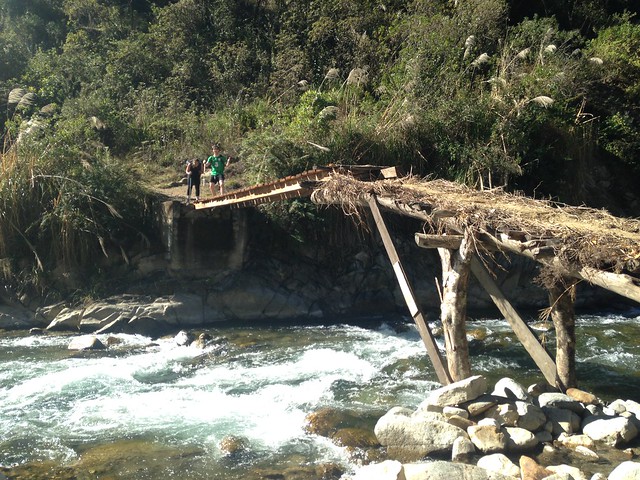
Crossing bridges
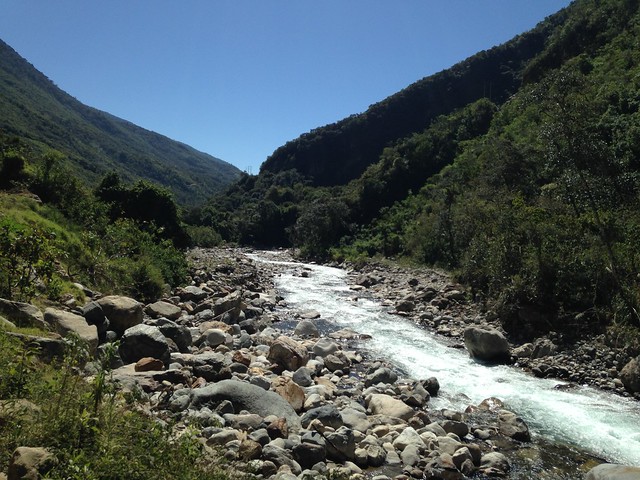
The rest of the group appeared unchallenged by any of this, and once again they bounded off into the distance. I now found myself unable to keep up at all. If I tried to go faster, I risked tripping and falling off the edge. If I tried to slow down, I risked getting further and further behind the rest of the group.
Thankfully, the rest of the group waited at a nearby tree house so I could catch up, and we managed to finish the walk without any further mishaps or near-death experiences.
After a delicious lunch of ceviche, fried chicken and rice, we were driven to Santa Teresa, the small village where we would be camping, and taken to the local hot springs to soothe our sore muscles.
In the evening we reluctantly danced around a campfire with Christian and two other groups who were also taking the Salkantay route. The quality of the music left a lot to be desired, but we did our best to take part by demonstrating our knowledge of the Macarena dance routine (about five times), and making up our own dance moves (such as pretending to be a condor) to some local latin tunes. Once again, we were exhausted, and with the exception of Ryan who stayed up late into the night, we headed to our tents as early as we could, and put in our ear plugs to block out the noises of other people having fun.
DAY THREE
We started the day with a welcome break from walking. Instead, we went ziplining. For just 100 Peruvian soles (about £25) we were able to zip over the river and back again several times, at significant height and speed. A terrifying walk over a huge rickety suspension bridge and rock climbing was also included, and we made the most of everything on offer.
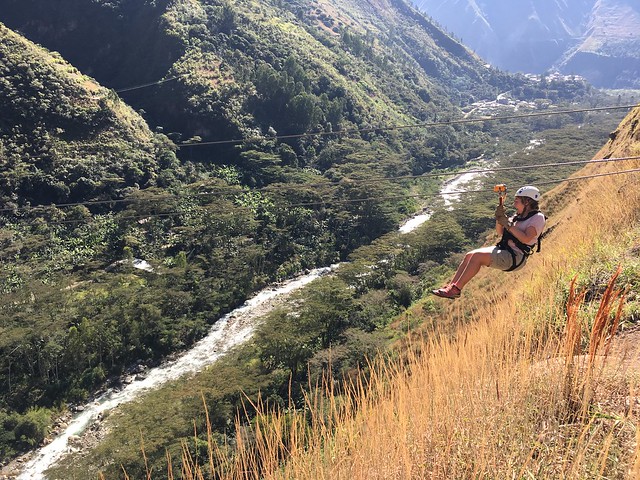
Ziplining
After a couple of hours of zipline fun, we remembered that we still had to finish our trek, and were taken to Hydroelectrica, a nearby train station where we would start our day’s walking. After lunch we began our “it’s only three hours” walk.
The walk along the train tracks wasn’t difficult, but our feet and legs were tired. As we neared Aguas Calientes, the closest town to Machu Picchu, we bumped into more and more people on our walk. We caught our first glimpse of Machu Picchu in the mountains, and enjoyed some green views around us, but once again I was too tired to really appreciate it.

Dodging the trains on day three
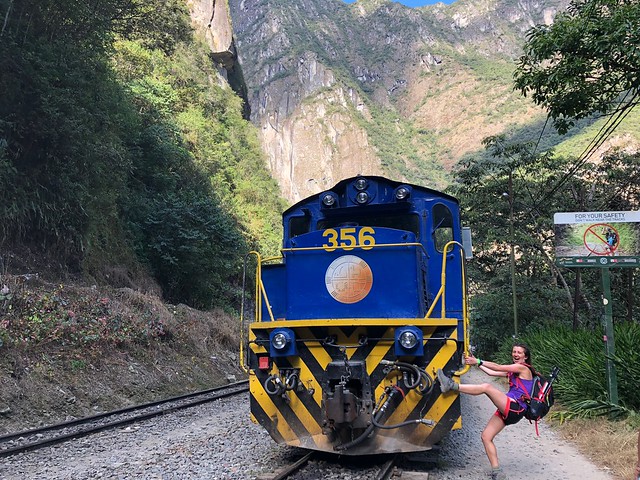
Army Andrea
We continued to dodge more people and more trains as we got closer and closer. Eventually I saw some small buildings nestled in the mountains in the distance. “Aguas Calientes”, Christian said, and pointed ahead. We were almost there, and I couldn’t have been happier to get to the end.
—
In the evening we were reunited with Hattie, who had been stuck in hospital in Arequipa and acclimatising in Cuzco, and hadn’t been able to complete the Inca Trail. She didn’t seem in a particularly good state, but we managed to get her to the nearby restaurant where we all enjoyed a delicious three course meal (including steak!), which was all included in the trek.
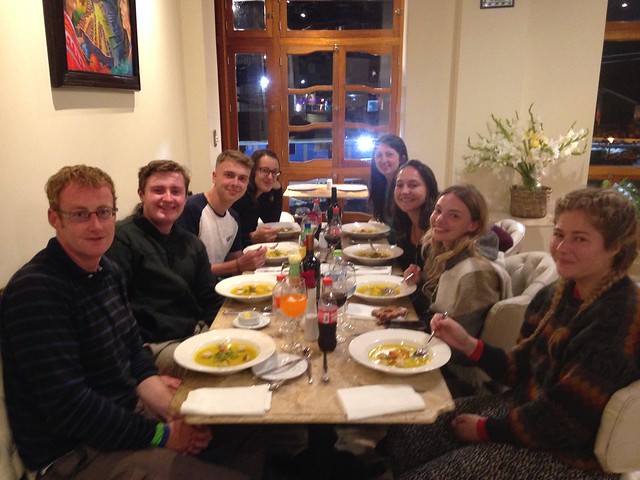
Enjoying a well-earned meal in Aguas Calientes
That night we stayed in the nicest hotel we have seen for a while (again, included in the Salkantay Trek), and prepared ourselves for yet another early morning. This time, to see Machu Picchu.
DAY FOUR
We woke up at 4am, got dressed in warm clothes, and headed down to reception ready to meet Christian at 4.30am and get in the queue for the bus from Aguas Calientes to Machu Picchu. Despite the fact that the first bus wasn’t due to leave until at least 5.30am, the queue for the bus was already lengthy, so Marisa got a head start on the rest of the group and saved us a place.
Having spent so much time in the middle of nowhere on the trek, it was strange to see so many people in such a small town. It was even stranger to see them all up at 4.30 in the morning, and jostling for places in the queue for the bus. We eventually met Christian and most of the rest of the group in the queue, and firmed up our place. After a while, we realised we were missing Will and Ryan, so Christian went up to their room to look for them. Sometime later they emerged, and confessed to over-sleeping, which wasn’t all that surprising after three long days of trekking. Eventually people started to pile on to the buses. We all squished on, and patiently waited as the bus climbed up the mountain to the entrance to Machu Picchu.
Once we reached the entrance, we found another, less orderly queue, and did our best to move slowly through it into the site. As we waited, Christian warned us we might want to use the toilets, as there were none inside Machu Picchu, and (as of the 1st of July 2018), our tickets only allowed us to enter the site once. If we needed the toilet and had to leave the site, we wouldn’t be allowed back in. Our tickets were valid from 6am to 12pm, which seemed a long time to go without using the loo, but with no other choice we took some last toilet breaks and then headed inside.
Hattie was still feeling poorly, so Andrea and Will took it in turns to give her a piggy back to the top of the site, where we watched the sun rise and took some photos. We then followed Christian on a semi-guided tour of Machu Picchu, where we learnt that the city was built around 1450-1460, was home to around 750 people, and was abandoned in around 1520, during the Spanish invasion of what is now Peru.
Although it is located only 80 kilometres from the Inca capital in Cuzco, the Spanish never found Machu Picchu. Over the years, the site was overgrown with jungle, and very few people outside the area knew it existed. It wasn’t re-discovered until the 1900s, when a local farmer came across the ruins. In 1911 American explorer Hiram Bingham brought national attention to the site, and since then it has been cleared, excavated, declared a “historic sanctuary” by Peru, a “World Heritage site” by UNESCO, and most recently, one of the ‘new’ “seven wonders of the world”, by the public.
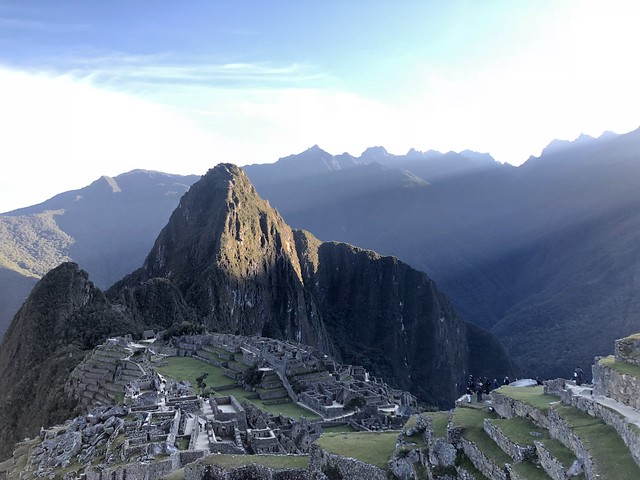
The iconic view
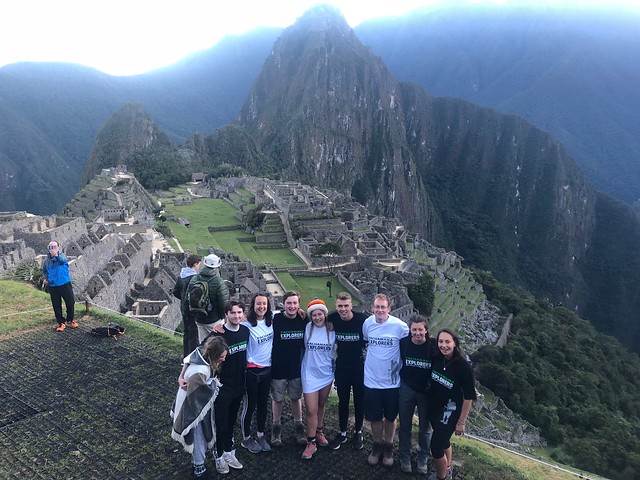
We made it!
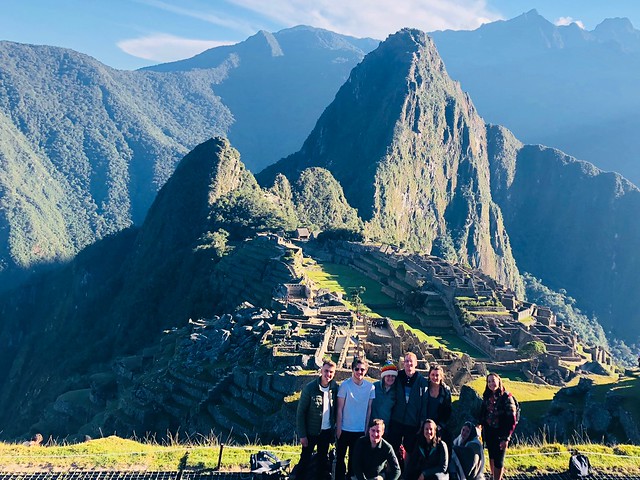
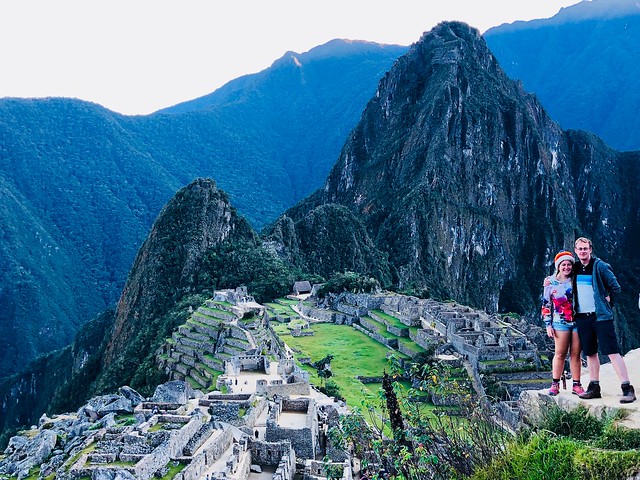
Christian led us around some of the sites on his tour, and then bid us farewell. Andrea headed off to climb one of the neighbouring peaks, Machu Picchu mountain, and the rest of us looked for somewhere to sit and take it all in. It was during this little rest period that one person in the group (who shall remain nameless) began to feel suddenly unwell. With the ONLY toilet back outside the entrance to the site, no easy way to get in or out, and the urge building, immediate action had to be taken.
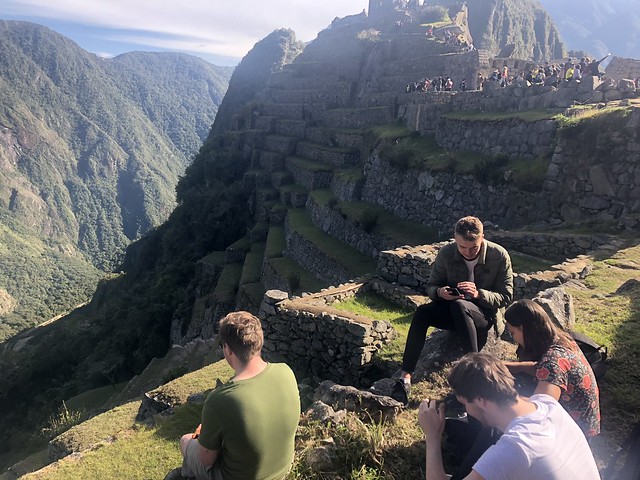
Chilling at the edge of Machu Picchu
There is no easy or polite way to write this. One member of the group had to do a poo ON Machu Picchu. Yes, the “wonder of the world” that is Machu Picchu now contains a poo on one of its many terraces. “So I left some of my DNA on Machu Picchu”, our friend said, trying to make light of the horror that had just unfolded. As soon as our friend felt well enough, we moved from our spot and tried to get ourselves through the rest of the site as quickly and discretely as possible.
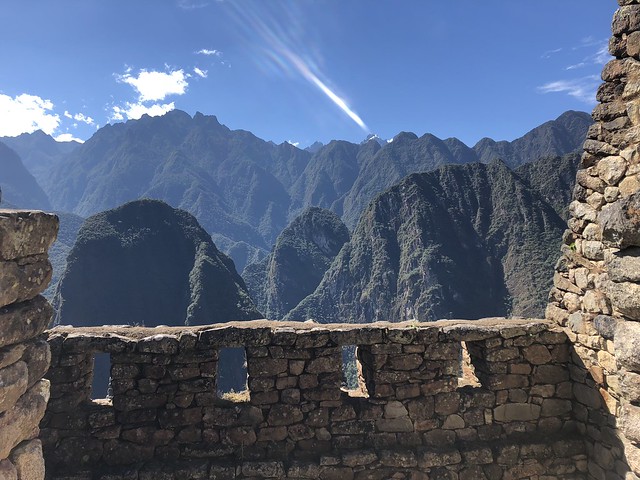
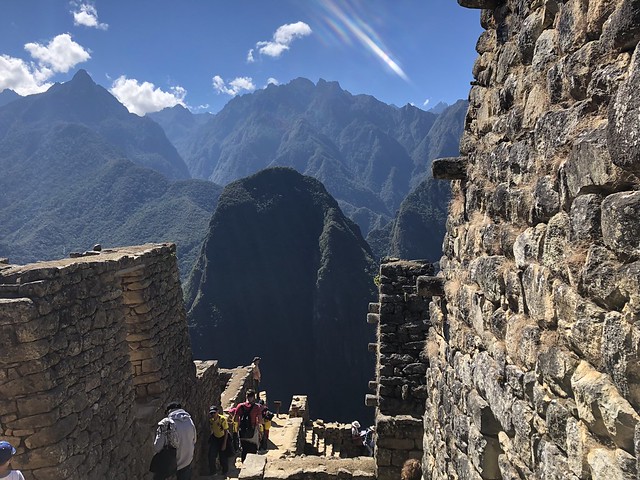
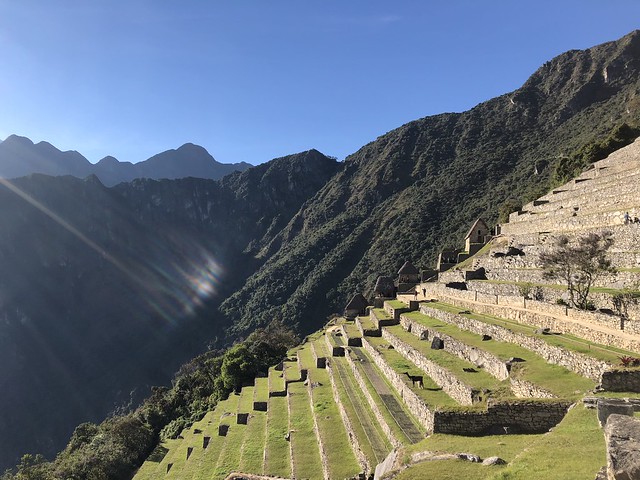
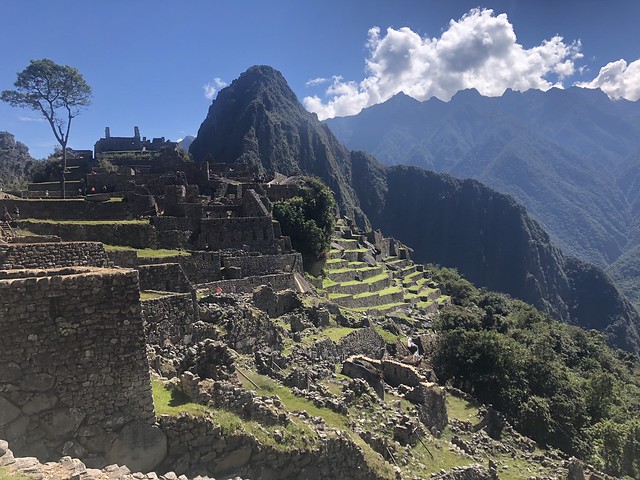
A little time passed before our friend started to feel very unwell again, and had to be sick. Again, ON Machu Picchu. By this point it was clear that we needed to leave, but the extensive, one-way system around the ruins made it difficult to make a quick exit. We did our best to find our way out, and took a bus back to Aguas Calientes.
Once back in the town, a few of us (not the Machu Picchu DNA dropper) found somewhere to eat and watch England narrowly beat Colombia at football. All was going well until we got the bill, and realised the had been charged an additional 20% ‘service charge’ which wasn’t mentioned anywhere on the menu, and given the generally appalling service (sadly usual for South America), the already exhorbitant prices, and the limited amount of money left in our wallets, we weren’t too happy about it.
Will argued for a long time, but ended up paying it in the end. Then Shane ended up arguing about it for even longer, and refused to pay it. “It’s a gringo tax”, Shane whispered to Will, “basically a scam”, so Will went back to try and retrieve his money. “I don’t want to pay gringo tax”, he said, and after a long, drawn-out argument, which mainly involved Will standing there and the waitresses ignoring him, somehow, he got his money back. After that, no one paid the gingo tax, and eventually Shane and Holly were asked to leave the restaurant.
With Christian long gone, and two members of our group (Hattie plus the Machu Picchu DNA dropper) quite unwell, it was a little stressful finding our way on to the train, and then the bus back to Cuzco. The train wasn’t exactly the speediest mode of transport, taking about two hours to travel less than 50 kilometres, but the mountain views were pretty and free snacks were provided.
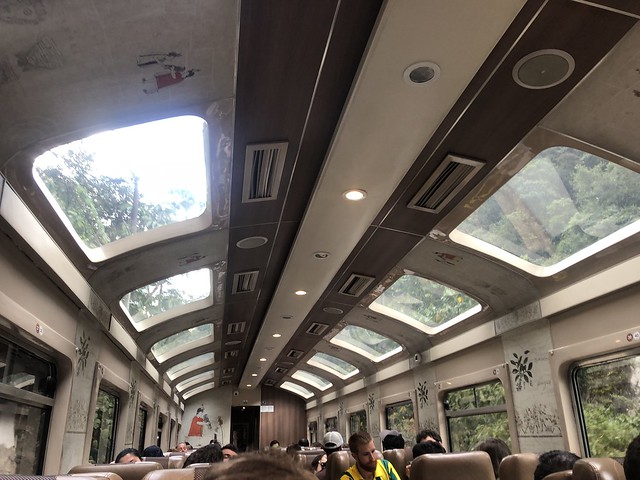
Big windows on the train
We then faced into a two hour bus ride, where we managed to sing songs continuously all the way back to Cuzco. Once we arrived it was getting late. We checked in, grabbed some painfully slow ‘fast food’ from a local takeaway, and headed to bed.
—
It took four days, two 4am starts, 100,000 steps, one high mountain pass, and one emergency poo on an ancient Inca site, but somehow we survived the Salkantay Trek to Machu Picchu. Despite the leisurely trips to the hot springs and the ziplining, as well as the hotel stay in Aguas Calientes (none of which occurs on the classic Inca Trail), I still found the four day trek very challenging. Getting up early, scaling mountains and walking for what felt like days on end did not come naturally to me, but I am pleased I got to see Machu Picchu, and that I took the scenic route.
While spectacular, Machu Picchu risks becoming a giant toilet if the Peruvian government fails to provide adequate facilities or re-think its policy on ‘one entrance’ only. If nothing changes, the once celebrated Machu Picchu may well become something else entirely. Machu Poochu, perhaps.
